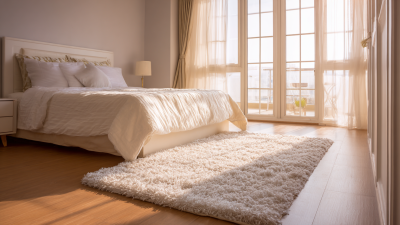Innovative Ways to Use Imitation Grass Matting in Your Home and Garden
In recent years, the trend of incorporating imitation grass matting into home and garden designs has gained immense popularity due to its versatility and aesthetic appeal. This innovative material not only enhances the visual landscape of various spaces but also provides practical solutions for homeowners looking to achieve a lush, green appearance without the maintenance demands of natural grass.
 From transforming outdoor patios into cozy retreats to creating playful indoor play areas for children, imitation grass matting offers a myriad of uses that go beyond traditional applications. In this blog, we will explore five compelling reasons to consider imitation grass matting for your own home and garden, showcasing how this modern solution can elevate your living spaces while providing durability and ease of care.
Join us as we delve into these creative ways to enrich your home environment with the charm and functionality of imitation grass matting.
From transforming outdoor patios into cozy retreats to creating playful indoor play areas for children, imitation grass matting offers a myriad of uses that go beyond traditional applications. In this blog, we will explore five compelling reasons to consider imitation grass matting for your own home and garden, showcasing how this modern solution can elevate your living spaces while providing durability and ease of care.
Join us as we delve into these creative ways to enrich your home environment with the charm and functionality of imitation grass matting.
Innovative Applications of Imitation Grass Matting for Eco-Friendly Landscaping
Imitation grass matting has emerged as a game-changer in eco-friendly landscaping, offering sustainable alternatives to traditional lawn options. According to a 2021 report by the International Turfgrass Society, synthetic grass can reduce water usage by up to 70% compared to natural grass. This makes it an excellent choice for homeowners looking to conserve water while still enjoying a green space. The versatility of imitation grass matting allows it to be used in various applications, from residential lawns to outdoor play areas and even on rooftops, creating appealing, low-maintenance green spaces.
Moreover, the environmental benefits extend beyond water conservation. Research from the Environmental Protection Agency indicates that synthetic turf can significantly decrease chemical runoff since it eliminates the need for pesticides and fertilizers typically used on natural lawns. This not only contributes to healthier ecosystems but also reduces the carbon footprint associated with lawn maintenance. Creative uses of imitation grass matting include creating pathways, picnic areas, or even vertical gardens, allowing for the integration of green aesthetics without the environmental costs associated with natural grass. As these trends continue to gain traction, homeowners and landscapers alike are discovering the advantages of using imitation grass matting in their outdoor and indoor environments.
Transforming Indoor Spaces: Creative Uses of Synthetic Turf in Home Decor
Synthetic turf, often associated with sports fields and outdoor spaces, has made its way into home decor, offering innovative possibilities for transforming indoor environments. Recent industry reports indicate that the synthetic turf market in residential applications is projected to grow at a CAGR of 10.6% from 2021 to 2028. This growth highlights the increasing trend of utilizing imitation grass matting to create vibrant, low-maintenance indoor spaces.
In living rooms and play areas, synthetic turf mats can add a touch of nature while providing safety and comfort. By covering floors with soft, plush mats, homeowners can create a cozy, inviting atmosphere that is also easy to clean. Additionally, the versatility of imitation grass allows it to be used as wall art or a backdrop for indoor plant displays, effectively blurring the lines between great design and biophilic elements. According to a study by Tracxn Technologies, consumer interest in eco-friendly home solutions has risen by over 30% in the last year, suggesting that more people are turning to alternative materials like artificial grass to enhance their interiors without sacrificing style or sustainability.
Innovative Uses of Imitation Grass Matting in Home Decor
Enhancing Outdoor Living Areas with Durable and Stylish Grass Matting Solutions
Imitation grass matting is revolutionizing outdoor living spaces, providing both aesthetic appeal and practical solutions for homeowners. According to a report by MarketsandMarkets, the global artificial grass market is projected to grow from $2.97 billion in 2023 to $4.28 billion by 2028, highlighting a significant interest in durable and stylish outdoor enhancements. This surge is largely due to its low maintenance requirements and ability to withstand various weather conditions, making it an ideal choice for patios, decks, and garden pathways.
Incorporating imitation grass matting into outdoor areas not only enhances visual appeal but also contributes to sustainability. As per a study by the Synthetic Turf Council, the use of artificial grass can reduce water consumption by up to 70%, making it an eco-friendly option for homeowners looking to minimize their environmental footprint. Additionally, these mats provide a safe surface for children and pets to play on, reducing the risk of injuries associated with hard surfaces. With innovative designs and textures available, imitation grass matting is transforming outdoor living areas into stylish, functional spaces that elevate the overall home experience.
Innovative Ways to Use Imitation Grass Matting in Your Home and Garden
| Application Area | Benefits | Durability | Aesthetic Appeal |
|---|---|---|---|
| Patios | Easy maintenance, weather-resistant | 10+ years with proper care | Natural look enhances ambiance |
| Garden Pathways | Slip-resistant, adds greenery | Resilient against foot traffic | Blends seamlessly with plants |
| Play Areas | Safe for children, cushioned surface | Durable against wear and tear | Bright and inviting appearance |
| Balconies | Weatherproof, easy to clean | Lasts through outdoor elements | Modern and chic urban vibe |
| Event Spaces | Creates a festive atmosphere | Handles large crowds effectively | Visually appealing for gatherings |
The Environmental Benefits of Choosing Imitation Grass: A Sustainable Choice for Gardens
Imitation grass matting is not only a stylish addition to home and garden spaces but also a sustainable choice that offers numerous environmental benefits. As we become increasingly aware of the impact of our choices on the planet, opting for synthetic grass can significantly reduce water consumption and eliminate the need for harmful pesticides and fertilizers typically associated with natural lawns. This innovative solution allows homeowners to maintain lush, green areas without the significant ecological footprint that traditional grass requires.
Additionally, the rise in the imitation grass market, projected to grow from $269.06 million in 2024 to $422.67 million by 2032, speaks to a broader trend of eco-consciousness among consumers. By choosing imitation grass, homeowners can contribute to a more sustainable future while enjoying the aesthetics of green spaces year-round. The low maintenance nature of imitation grass also means less reliance on gas-powered lawn equipment, leading to further reductions in carbon emissions. As we seek to create beautiful yet environmentally friendly gardens, imitation grass matting presents an appealing, responsible option.
Top 5 Creative DIY Projects with Imitation Grass Matting for Home and Garden улучшения
Imitation grass matting has gained significant popularity as a versatile material for home and garden projects, making it an excellent choice for DIY enthusiasts. According to a report by Technavio, the artificial grass market is projected to grow by over $5 billion from 2021 to 2025, reflecting the increasing demand for low-maintenance landscaping solutions. One of the most creative ways to use imitation grass matting is by crafting custom outdoor rugs. Simply cut the matting to size and use it to create a comfortable, eco-friendly space for relaxation or entertainment in your garden.
In addition to outdoor rugs, imitation grass matting can be transformed into unique wall art. By cutting the matting into various shapes and sizes and mounting it on a canvas, homeowners can create an eye-catching focal point in their living spaces. Furthermore, a report from the American Society of Landscape Architects indicates that incorporating such elements can enhance property value and provide a modern aesthetic. Another innovative project involves using imitation grass for pet areas, providing a soft and clean environment for pets while reducing mud and dirt tracked into the house. The adaptability of imitation grass matting truly opens the door for endless creative projects that elevate both home and garden aesthetics.
Related Posts
-

Ultimate Checklist for Choosing the Perfect Imitation Grass Matting for Your Outdoor Space
-

Discover the Advantages of Choosing the Best Pvc Floor Mats for Your Home
-

How to Choose the Best Pvc Floor Mats For Home to Enhance Your Living Space
-

Top Strategies for Choosing the Best Double Ribbed Floor Mat for Your Business
-

Ultimate Guide to Choosing the Best Ribbed Outdoor Door Mat for Your Home
-

Top Strategies for Transforming Your Entrance with Extra Large Welcome Mats

